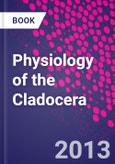The Physiology of Cladocera is a much-needed summary of foundational information on these increasingly important model organisms. This unique and valuable summary is based on the world's literature, including Russian research not widely available until now. It offers systematically arranged data on the physiology of Cladocera, assisting with explanation of their life and distribution, as well as discussion on directions of future research. Special expert contributions in genetics, immunology, and cytology round out the physiological chapters and provide comprehensive insight into the state of knowledge of Cladocera and its underlying mechanisms.
Cladocera crustaceans make up a significant part of the natural communities and biological productivity of fresh waters. In recent decades, they have become globally studied for many purposes, including systematics, genetic, molecular, ecological and evolutionary biology studies. They are also used as "sentinel" organisms for assessing water quality and the environment. In addition, the genome of Daphnia (a genus within Cladocera) was recently sequenced and published, giving this system a much wider exposure. It has also led to a rapidly growing awareness of the importance of understanding physiological processes as they relate to evolutionary and ecological genomics and ecogenomic toxicology.
Despite the increasing use of Cladocera in research and study, physiological background information on these creatures is fragmentary. Hundreds of unconnected publications have been accumulated on their physiology, and a synthesis and general representation of the literature has been much needed for the many researchers working with this organism. The Physiology of Cladocera stands alone as a valuable and comprehensive offering in this area for many researchers and students.
Table of Contents
Preface
Abbreviations and units
Introduction
Chapter 1. General
Chapter 2. Methods
Chapter 3. Chemical Composition
Chapter 4. Nutrition
Chapter 5. Respiration
Chapter 6. Circulation
Chapter 7. Excretion
Chapter 8. Osmotic Regulation
Chapter 9. Cell and Tissue Metabolism
Chapter 10. Growth and Molting
Chapter 11. Reproduction
Chapter 12. Locomotion
Chapter 13. Nervous System and Sense Organs
Chapter 14. Behavior
Chapter 15. Ecophysiology
Chapter 16. A Cytological Perspective
Margaret J. Beaton and Carli M. Peters
Chapter 17. Immunology and Immunity
Stuart Auld
Chapter 18. The Genomics of Cladoceran Physiology
Dörthe Becker, Kay Van Damme, Elizabeth Turner, Joseph R. Shaw, John K. Colbourne and Michael E. Pfrender
Conclusions: Special Traits of Cladoceran Physiology
References
Index of Latin names of Crustacea
Index of chemical substances








